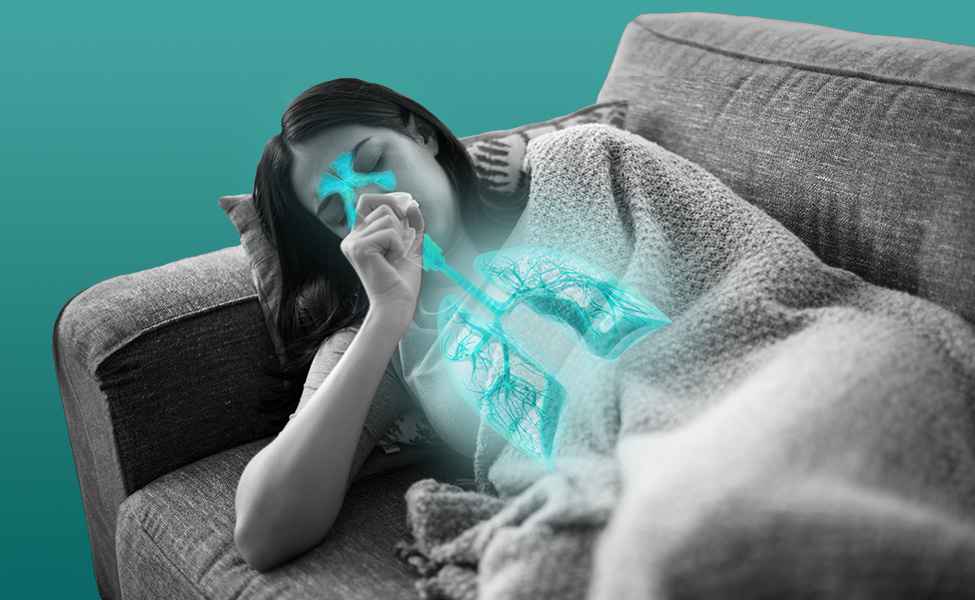Clinical Study
The Burden and Challenges of Community-Acquired Pneumonia Diagnosis

Dr. Janie French • Sep. 19, 2024
Community-acquired pneumonia (CAP) remains one of the most significant diagnostic challenges in the outpatient setting in the United States. As a leading cause of hospital admissions and mortality globally, CAP’s burden is profound, with millions of cases and deaths occurring annually. Despite advancements in vaccines and treatments, accurately diagnosing CAP remains a persistent issue, often leading to diagnostic errors that contribute to delayed or inappropriate care. Recent studies emphasize the importance of improved diagnostic tools, such as syndromic PCR testing, to address the unmet clinical needs in CAP diagnosis. This article explores the challenges surrounding CAP diagnosis and how emerging diagnostic technologies hold promise for reducing errors and improving patient outcomes.
Diagnostic errors due to missed, delayed, or wrong diagnoses are of increasing concern in the outpatient setting [1]. In the United States, diagnostic errors are the most common form of medical error, and they are most often associated with ‘The Big Three’: vascular events, cancers, and infections [2]. Specifically, in the primary care setting, community-acquired pneumonia (CAP) is among the most commonly missed diagnoses [3]. CAP is often differentiated from hospital-acquired pneumonia (HAP) because the responsible microorganisms differ significantly between them [4]. These infections are a leading cause of hospital admissions and mortality, with an estimated 489 million incidents and 2.5 million deaths annually worldwide [5]. In 2020, COVID-19 and CAP were the third and ninth overall cause of death in the US, respectively [6], and the second most frequent cause of hospitalization in the United States, with 36 hospital stays per 10,000 population from 2005-2009 [7]. With the widespread availability of the pneumococcal vaccine, CAP rates have decreased since 1997 [7, 8]. However, there is still a significant economic burden due to CAP, with over 17 billion dollars spent annually in the US related to CAP [9]. With such abysmal results, it is prudent to question the paradigm used to diagnose and treat CAP patients.
Pneumonia can be challenging to diagnose based on clinical symptoms alone, as there are no individual clinical symptoms or combinations of symptoms that conclusively establish pneumonia [10]. A chest radiograph is required to definitively identify CAP. The current spattering of tests performed when CAP is suspected has been shown to only identify a causative pathogen in 38% of cases [8]. In 2013, the IDSA published a policy paper reviewing the current diagnostic field and described CAP as an area with unmet diagnostic needs in the outpatient clinic [11]. The 2019 Infectious Disease Society of America (IDSA) and American Thoracic Society (ATS) guidelines for CAP neither recommend nor oppose sputum culture in adults being managed in the hospital setting, oppose blood cultures for patients managed in the outpatient setting, and suggest against the use of pneumococcal or legionella urine antigen except in severe CAP [12]. This is owing to a previous lack of high-quality studies demonstrating the value of diagnostic testing for patient outcomes [12]. However, the cited studies only utilized classical techniques such as sputum culture, gram stain, blood culture, and urinary antigen for pathogen-directed therapy of bacteria [12-14]. The only guidelines around PCR were focused on testing for influenza virus, as these guidelines were established before the emergence of SARS-CoV-2 (COVID-19) and the widespread availability of PCR testing [12]. Additionally, diagnosis of CAP can be challenging due to the difficulty of acquiring a high-quality sputum sample. For example, a study evaluating patients diagnosed with CAP in a primary care hospital found that only 36% were capable of producing a sputum sample [15]. Rapid diagnostics are critical to improved patient outcomes, as antiviral efficacy is greatest when given soon after symptoms begin [16-18].
Improved diagnostics, such as syndromic PCR with rapid turn-around time, could potentially reduce unnecessary antibiotic exposure, increase appropriate antiviral use, reduce hospital length of stays, and reduce overall patient costs. In 2013, the IDSA even described syndromic PCR testing for CAP as an area with the potential to address unmet clinical needs [11]. PCR has many strengths compared to traditional diagnostics: contaminants do not prevent the identification of other organisms, multiple types of pathogens can be identified from the same sample (virus, bacteria, fungi, etc.), it’s much faster than culture, high sensitivity, and high specificity. Recent studies have begun to examine the utility of rapid PCR for diagnosing and directing treatment for viral and bacterial pathogens causing CAP [19]. This study, a randomized clinical trial of emergency department patients with CAP found that use of the syndromic PCR test reduced the median time to treatment and had a larger proportion of patients receiving only one dose of antibiotics, suggesting possible reduced antibiotic exposure [19]. Additionally, studies looking at the diagnostic utility of PCR in CAP patients found high agreement between oropharyngeal and sputum samples (spontaneous and induced) [20], suggesting that PCR may also be beneficial for directing treatment in patients unable to produce sputum. As multiplex PCR has the ability to detect bacteria in the presence of contaminants, it may be able to reduce diagnostic errors associated with CAP and improve the frequency with which patients receive narrow-spectrum, pathogen-directed treatment. Because PCR can also detect viral and bacterial pathogens from the same sample, it has the potential to reduce the need for numerous diagnostic tests with many sample types that are typically performed for CAP patients. As access to PCR continues to expand, additional studies are needed to better understand the clinical utility of PCR for pneumonia and to describe the clinical outcomes associated with patients receiving a PCR test with rapid results, especially in the outpatient space
References
- Bishop, T.F., A.M. Ryan, and L.P. Casalino, Paid malpractice claims for adverse events in inpatient and outpatient settings. JAMA, 2011. 305(23): p. 2427-31.
- Newman-Toker, D.E., et al., Burden of serious harms from diagnostic error in the USA. BMJ Qual Saf, 2024. 33(2): p. 109-120.
- Singh, H., et al., Types and origins of diagnostic errors in primary care settings. JAMA Intern Med, 2013. 173(6): p. 418-25.
- Torres, A., et al., Pneumonia. Nat Rev Dis Primers, 2021. 7(1): p. 25.
- Collaborators, G.L., Age-sex differences in the global burden of lower respiratory infections and risk factors, 1990-2019: results from the Global Burden of Disease Study 2019. Lancet Infect Dis, 2022. 22(11): p. 1626-1647.
- Kochanek, K.D., et al., Deaths: Final Data for 2020. Natl Vital Stat Rep, 2023. 72(10): p. 1-92.
- Pfuntner, A., L.M. Wier, and C. Stocks, Most Frequent Conditions in U.S. Hospitals, 2011, in Healthcare Cost and Utilization Project (HCUP) Statistical Briefs. 2006: Rockville (MD).
- Jain, S., et al., Community-Acquired Pneumonia Requiring Hospitalization among U.S. Adults. N Engl J Med, 2015. 373(5): p. 415-27.
- File, T.M., Jr. and T.J. Marrie, Burden of community-acquired pneumonia in North American adults. Postgrad Med, 2010. 122(2): p. 130-41.
- Metlay, J.P., W.N. Kapoor, and M.J. Fine, Does this patient have community-acquired pneumonia? Diagnosing pneumonia by history and physical examination. JAMA, 1997. 278(17): p. 1440-5.
- Caliendo, A.M., et al., Better tests, better care: improved diagnostics for infectious diseases. Clin Infect Dis, 2013. 57 Suppl 3(Suppl 3): p. S139-70.
- Metlay, J.P., et al., Diagnosis and Treatment of Adults with Community-acquired Pneumonia. An Official Clinical Practice Guideline of the American Thoracic Society and Infectious Diseases Society of America. Am J Respir Crit Care Med, 2019. 200(7): p. e45-e67.
- Ewig, S., et al., Factors associated with unknown aetiology in patients with community-acquired pneumonia. Eur Respir J, 2002. 20(5): p. 1254-62.
- van der Eerden, M.M., et al., Comparison between pathogen directed antibiotic treatment and empirical broad spectrum antibiotic treatment in patients with community acquired pneumonia: a prospective randomised study. Thorax, 2005. 60(8): p. 672-8.
- Ewig, S., et al., Applying sputum as a diagnostic tool in pneumonia: limited yield, minimal impact on treatment decisions. Chest, 2002. 121(5): p. 1486-92.
- Beigel, J.H., et al., Remdesivir for the Treatment of Covid-19 – Final Report. N Engl J Med, 2020. 383(19): p. 1813-1826.
- Fry, A.M., et al., Efficacy of oseltamivir treatment started within 5 days of symptom onset to reduce influenza illness duration and virus shedding in an urban setting in Bangladesh: a randomised placebo-controlled trial. Lancet Infect Dis, 2014. 14(2): p. 109-18.
- Kositpantawong, N., et al., Outcomes of early oseltamivir treatment for hospitalized adult patients with community-acquired influenza pneumonia. PLoS One, 2021. 16(12): p. e0261411.
- Markussen, D.L., et al., Diagnostic Stewardship in Community-Acquired Pneumonia With Syndromic Molecular Testing: A Randomized Clinical Trial. JAMA Netw Open, 2024. 7(3): p. e240830.
- Serigstad, S., et al., Diagnostic utility of oropharyngeal swabs as an alternative to lower respiratory tract samples for PCR-based syndromic testing in patients with community-acquired pneumonia. J Clin Microbiol, 2023. 61(9): p. e0050523.
References
- Bishop, T.F., A.M. Ryan, and L.P. Casalino, Paid malpractice claims for adverse events in inpatient and outpatient settings. JAMA, 2011. 305(23): p. 2427-31.
- Newman-Toker, D.E., et al., Burden of serious harms from diagnostic error in the USA. BMJ Qual Saf, 2024. 33(2): p. 109-120.
- Singh, H., et al., Types and origins of diagnostic errors in primary care settings. JAMA Intern Med, 2013. 173(6): p. 418-25.
- Torres, A., et al., Pneumonia. Nat Rev Dis Primers, 2021. 7(1): p. 25.
- Collaborators, G.L., Age-sex differences in the global burden of lower respiratory infections and risk factors, 1990-2019: results from the Global Burden of Disease Study 2019. Lancet Infect Dis, 2022. 22(11): p. 1626-1647.
- Kochanek, K.D., et al., Deaths: Final Data for 2020. Natl Vital Stat Rep, 2023. 72(10): p. 1-92.
- Pfuntner, A., L.M. Wier, and C. Stocks, Most Frequent Conditions in U.S. Hospitals, 2011, in Healthcare Cost and Utilization Project (HCUP) Statistical Briefs. 2006: Rockville (MD).
- Jain, S., et al., Community-Acquired Pneumonia Requiring Hospitalization among U.S. Adults. N Engl J Med, 2015. 373(5): p. 415-27.
- File, T.M., Jr. and T.J. Marrie, Burden of community-acquired pneumonia in North American adults. Postgrad Med, 2010. 122(2): p. 130-41.
- Metlay, J.P., W.N. Kapoor, and M.J. Fine, Does this patient have community-acquired pneumonia? Diagnosing pneumonia by history and physical examination. JAMA, 1997. 278(17): p. 1440-5.
- Caliendo, A.M., et al., Better tests, better care: improved diagnostics for infectious diseases. Clin Infect Dis, 2013. 57 Suppl 3(Suppl 3): p. S139-70.
- Metlay, J.P., et al., Diagnosis and Treatment of Adults with Community-acquired Pneumonia. An Official Clinical Practice Guideline of the American Thoracic Society and Infectious Diseases Society of America. Am J Respir Crit Care Med, 2019. 200(7): p. e45-e67.
- Ewig, S., et al., Factors associated with unknown aetiology in patients with community-acquired pneumonia. Eur Respir J, 2002. 20(5): p. 1254-62.
- van der Eerden, M.M., et al., Comparison between pathogen directed antibiotic treatment and empirical broad spectrum antibiotic treatment in patients with community acquired pneumonia: a prospective randomised study. Thorax, 2005. 60(8): p. 672-8.
- Ewig, S., et al., Applying sputum as a diagnostic tool in pneumonia: limited yield, minimal impact on treatment decisions. Chest, 2002. 121(5): p. 1486-92.
- Beigel, J.H., et al., Remdesivir for the Treatment of Covid-19 – Final Report. N Engl J Med, 2020. 383(19): p. 1813-1826.
- Fry, A.M., et al., Efficacy of oseltamivir treatment started within 5 days of symptom onset to reduce influenza illness duration and virus shedding in an urban setting in Bangladesh: a randomised placebo-controlled trial. Lancet Infect Dis, 2014. 14(2): p. 109-18.
- Kositpantawong, N., et al., Outcomes of early oseltamivir treatment for hospitalized adult patients with community-acquired influenza pneumonia. PLoS One, 2021. 16(12): p. e0261411.
- Markussen, D.L., et al., Diagnostic Stewardship in Community-Acquired Pneumonia With Syndromic Molecular Testing: A Randomized Clinical Trial. JAMA Netw Open, 2024. 7(3): p. e240830.
- Serigstad, S., et al., Diagnostic utility of oropharyngeal swabs as an alternative to lower respiratory tract samples for PCR-based syndromic testing in patients with community-acquired pneumonia. J Clin Microbiol, 2023. 61(9): p. e0050523.
Related Articles and White papers

Dr. Janie French • Sep. 19, 2024
Community-acquired pneumonia (CAP) remains one of the most significant diagnostic challenges in the outpatient setting in the United States. As a leading cause of hospital admissions and mortality globally, CAP’s burden is profound, with millions of cases and deaths occurring annually. Despite advancements in vaccines and treatments, accurately diagnosing CAP remains a persistent issue, often leading to diagnostic errors that contribute to delayed or inappropriate care. Recent studies emphasize the importance of improved diagnostic tools, such as syndromic PCR testing, to address the unmet clinical needs in CAP diagnosis. This article explores the challenges surrounding CAP diagnosis and how emerging diagnostic technologies hold promise for reducing errors and improving patient outcomes.
Diagnostic errors due to missed, delayed, or wrong diagnoses are of increasing concern in the outpatient setting [1]. In the United States, diagnostic errors are the most common form of medical error, and they are most often associated with ‘The Big Three’: vascular events, cancers, and infections [2]. Specifically, in the primary care setting, community-acquired pneumonia (CAP) is among the most commonly missed diagnoses [3]. CAP is often differentiated from hospital-acquired pneumonia (HAP) because the responsible microorganisms differ significantly between them [4]. These infections are a leading cause of hospital admissions and mortality, with an estimated 489 million incidents and 2.5 million deaths annually worldwide [5]. In 2020, COVID-19 and CAP were the third and ninth overall cause of death in the US, respectively [6], and the second most frequent cause of hospitalization in the United States, with 36 hospital stays per 10,000 population from 2005-2009 [7]. With the widespread availability of the pneumococcal vaccine, CAP rates have decreased since 1997 [7, 8]. However, there is still a significant economic burden due to CAP, with over 17 billion dollars spent annually in the US related to CAP [9]. With such abysmal results, it is prudent to question the paradigm used to diagnose and treat CAP patients.
Pneumonia can be challenging to diagnose based on clinical symptoms alone, as there are no individual clinical symptoms or combinations of symptoms that conclusively establish pneumonia [10]. A chest radiograph is required to definitively identify CAP. The current spattering of tests performed when CAP is suspected has been shown to only identify a causative pathogen in 38% of cases [8]. In 2013, the IDSA published a policy paper reviewing the current diagnostic field and described CAP as an area with unmet diagnostic needs in the outpatient clinic [11]. The 2019 Infectious Disease Society of America (IDSA) and American Thoracic Society (ATS) guidelines for CAP neither recommend nor oppose sputum culture in adults being managed in the hospital setting, oppose blood cultures for patients managed in the outpatient setting, and suggest against the use of pneumococcal or legionella urine antigen except in severe CAP [12]. This is owing to a previous lack of high-quality studies demonstrating the value of diagnostic testing for patient outcomes [12]. However, the cited studies only utilized classical techniques such as sputum culture, gram stain, blood culture, and urinary antigen for pathogen-directed therapy of bacteria [12-14]. The only guidelines around PCR were focused on testing for influenza virus, as these guidelines were established before the emergence of SARS-CoV-2 (COVID-19) and the widespread availability of PCR testing [12]. Additionally, diagnosis of CAP can be challenging due to the difficulty of acquiring a high-quality sputum sample. For example, a study evaluating patients diagnosed with CAP in a primary care hospital found that only 36% were capable of producing a sputum sample [15]. Rapid diagnostics are critical to improved patient outcomes, as antiviral efficacy is greatest when given soon after symptoms begin [16-18].
Improved diagnostics, such as syndromic PCR with rapid turn-around time, could potentially reduce unnecessary antibiotic exposure, increase appropriate antiviral use, reduce hospital length of stays, and reduce overall patient costs. In 2013, the IDSA even described syndromic PCR testing for CAP as an area with the potential to address unmet clinical needs [11]. PCR has many strengths compared to traditional diagnostics: contaminants do not prevent the identification of other organisms, multiple types of pathogens can be identified from the same sample (virus, bacteria, fungi, etc.), it’s much faster than culture, high sensitivity, and high specificity. Recent studies have begun to examine the utility of rapid PCR for diagnosing and directing treatment for viral and bacterial pathogens causing CAP [19]. This study, a randomized clinical trial of emergency department patients with CAP found that use of the syndromic PCR test reduced the median time to treatment and had a larger proportion of patients receiving only one dose of antibiotics, suggesting possible reduced antibiotic exposure [19]. Additionally, studies looking at the diagnostic utility of PCR in CAP patients found high agreement between oropharyngeal and sputum samples (spontaneous and induced) [20], suggesting that PCR may also be beneficial for directing treatment in patients unable to produce sputum. As multiplex PCR has the ability to detect bacteria in the presence of contaminants, it may be able to reduce diagnostic errors associated with CAP and improve the frequency with which patients receive narrow-spectrum, pathogen-directed treatment. Because PCR can also detect viral and bacterial pathogens from the same sample, it has the potential to reduce the need for numerous diagnostic tests with many sample types that are typically performed for CAP patients. As access to PCR continues to expand, additional studies are needed to better understand the clinical utility of PCR for pneumonia and to describe the clinical outcomes associated with patients receiving a PCR test with rapid results, especially in the outpatient space
References
- Bishop, T.F., A.M. Ryan, and L.P. Casalino, Paid malpractice claims for adverse events in inpatient and outpatient settings. JAMA, 2011. 305(23): p. 2427-31.
- Newman-Toker, D.E., et al., Burden of serious harms from diagnostic error in the USA. BMJ Qual Saf, 2024. 33(2): p. 109-120.
- Singh, H., et al., Types and origins of diagnostic errors in primary care settings. JAMA Intern Med, 2013. 173(6): p. 418-25.
- Torres, A., et al., Pneumonia. Nat Rev Dis Primers, 2021. 7(1): p. 25.
- Collaborators, G.L., Age-sex differences in the global burden of lower respiratory infections and risk factors, 1990-2019: results from the Global Burden of Disease Study 2019. Lancet Infect Dis, 2022. 22(11): p. 1626-1647.
- Kochanek, K.D., et al., Deaths: Final Data for 2020. Natl Vital Stat Rep, 2023. 72(10): p. 1-92.
- Pfuntner, A., L.M. Wier, and C. Stocks, Most Frequent Conditions in U.S. Hospitals, 2011, in Healthcare Cost and Utilization Project (HCUP) Statistical Briefs. 2006: Rockville (MD).
- Jain, S., et al., Community-Acquired Pneumonia Requiring Hospitalization among U.S. Adults. N Engl J Med, 2015. 373(5): p. 415-27.
- File, T.M., Jr. and T.J. Marrie, Burden of community-acquired pneumonia in North American adults. Postgrad Med, 2010. 122(2): p. 130-41.
- Metlay, J.P., W.N. Kapoor, and M.J. Fine, Does this patient have community-acquired pneumonia? Diagnosing pneumonia by history and physical examination. JAMA, 1997. 278(17): p. 1440-5.
- Caliendo, A.M., et al., Better tests, better care: improved diagnostics for infectious diseases. Clin Infect Dis, 2013. 57 Suppl 3(Suppl 3): p. S139-70.
- Metlay, J.P., et al., Diagnosis and Treatment of Adults with Community-acquired Pneumonia. An Official Clinical Practice Guideline of the American Thoracic Society and Infectious Diseases Society of America. Am J Respir Crit Care Med, 2019. 200(7): p. e45-e67.
- Ewig, S., et al., Factors associated with unknown aetiology in patients with community-acquired pneumonia. Eur Respir J, 2002. 20(5): p. 1254-62.
- van der Eerden, M.M., et al., Comparison between pathogen directed antibiotic treatment and empirical broad spectrum antibiotic treatment in patients with community acquired pneumonia: a prospective randomised study. Thorax, 2005. 60(8): p. 672-8.
- Ewig, S., et al., Applying sputum as a diagnostic tool in pneumonia: limited yield, minimal impact on treatment decisions. Chest, 2002. 121(5): p. 1486-92.
- Beigel, J.H., et al., Remdesivir for the Treatment of Covid-19 – Final Report. N Engl J Med, 2020. 383(19): p. 1813-1826.
- Fry, A.M., et al., Efficacy of oseltamivir treatment started within 5 days of symptom onset to reduce influenza illness duration and virus shedding in an urban setting in Bangladesh: a randomised placebo-controlled trial. Lancet Infect Dis, 2014. 14(2): p. 109-18.
- Kositpantawong, N., et al., Outcomes of early oseltamivir treatment for hospitalized adult patients with community-acquired influenza pneumonia. PLoS One, 2021. 16(12): p. e0261411.
- Markussen, D.L., et al., Diagnostic Stewardship in Community-Acquired Pneumonia With Syndromic Molecular Testing: A Randomized Clinical Trial. JAMA Netw Open, 2024. 7(3): p. e240830.
- Serigstad, S., et al., Diagnostic utility of oropharyngeal swabs as an alternative to lower respiratory tract samples for PCR-based syndromic testing in patients with community-acquired pneumonia. J Clin Microbiol, 2023. 61(9): p. e0050523.
References
- Bishop, T.F., A.M. Ryan, and L.P. Casalino, Paid malpractice claims for adverse events in inpatient and outpatient settings. JAMA, 2011. 305(23): p. 2427-31.
- Newman-Toker, D.E., et al., Burden of serious harms from diagnostic error in the USA. BMJ Qual Saf, 2024. 33(2): p. 109-120.
- Singh, H., et al., Types and origins of diagnostic errors in primary care settings. JAMA Intern Med, 2013. 173(6): p. 418-25.
- Torres, A., et al., Pneumonia. Nat Rev Dis Primers, 2021. 7(1): p. 25.
- Collaborators, G.L., Age-sex differences in the global burden of lower respiratory infections and risk factors, 1990-2019: results from the Global Burden of Disease Study 2019. Lancet Infect Dis, 2022. 22(11): p. 1626-1647.
- Kochanek, K.D., et al., Deaths: Final Data for 2020. Natl Vital Stat Rep, 2023. 72(10): p. 1-92.
- Pfuntner, A., L.M. Wier, and C. Stocks, Most Frequent Conditions in U.S. Hospitals, 2011, in Healthcare Cost and Utilization Project (HCUP) Statistical Briefs. 2006: Rockville (MD).
- Jain, S., et al., Community-Acquired Pneumonia Requiring Hospitalization among U.S. Adults. N Engl J Med, 2015. 373(5): p. 415-27.
- File, T.M., Jr. and T.J. Marrie, Burden of community-acquired pneumonia in North American adults. Postgrad Med, 2010. 122(2): p. 130-41.
- Metlay, J.P., W.N. Kapoor, and M.J. Fine, Does this patient have community-acquired pneumonia? Diagnosing pneumonia by history and physical examination. JAMA, 1997. 278(17): p. 1440-5.
- Caliendo, A.M., et al., Better tests, better care: improved diagnostics for infectious diseases. Clin Infect Dis, 2013. 57 Suppl 3(Suppl 3): p. S139-70.
- Metlay, J.P., et al., Diagnosis and Treatment of Adults with Community-acquired Pneumonia. An Official Clinical Practice Guideline of the American Thoracic Society and Infectious Diseases Society of America. Am J Respir Crit Care Med, 2019. 200(7): p. e45-e67.
- Ewig, S., et al., Factors associated with unknown aetiology in patients with community-acquired pneumonia. Eur Respir J, 2002. 20(5): p. 1254-62.
- van der Eerden, M.M., et al., Comparison between pathogen directed antibiotic treatment and empirical broad spectrum antibiotic treatment in patients with community acquired pneumonia: a prospective randomised study. Thorax, 2005. 60(8): p. 672-8.
- Ewig, S., et al., Applying sputum as a diagnostic tool in pneumonia: limited yield, minimal impact on treatment decisions. Chest, 2002. 121(5): p. 1486-92.
- Beigel, J.H., et al., Remdesivir for the Treatment of Covid-19 – Final Report. N Engl J Med, 2020. 383(19): p. 1813-1826.
- Fry, A.M., et al., Efficacy of oseltamivir treatment started within 5 days of symptom onset to reduce influenza illness duration and virus shedding in an urban setting in Bangladesh: a randomised placebo-controlled trial. Lancet Infect Dis, 2014. 14(2): p. 109-18.
- Kositpantawong, N., et al., Outcomes of early oseltamivir treatment for hospitalized adult patients with community-acquired influenza pneumonia. PLoS One, 2021. 16(12): p. e0261411.
- Markussen, D.L., et al., Diagnostic Stewardship in Community-Acquired Pneumonia With Syndromic Molecular Testing: A Randomized Clinical Trial. JAMA Netw Open, 2024. 7(3): p. e240830.
- Serigstad, S., et al., Diagnostic utility of oropharyngeal swabs as an alternative to lower respiratory tract samples for PCR-based syndromic testing in patients with community-acquired pneumonia. J Clin Microbiol, 2023. 61(9): p. e0050523.





